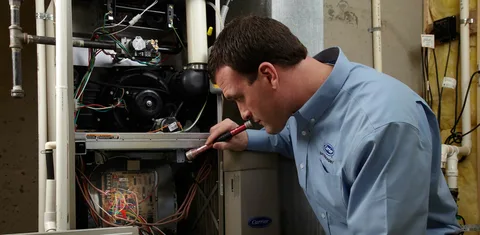How Can You Prevent Furnace Repairs with Regular Maintenance?
When the cold winter months arrive, your heating system becomes an essential part of your home’s comfort. However, many homeowners overlook the importance of regular furnace maintenance. Neglecting this crucial task can lead to unexpected breakdowns, costly repairs, and even a shortened lifespan for your furnace. So, how can you prevent costly repairs with regular maintenance? Let’s explore how simple upkeep routines can save you from expensive emergency repairs while ensuring your system runs efficiently and reliably.
Importance of Furnace Maintenance
Furnaces, like all mechanical systems, require routine maintenance to operate at peak performance. Think of it as an investment in the longevity of your unit. Much like getting your car’s oil changed to prevent engine problems, furnace maintenance keeps everything running smoothly. This preventive approach can catch minor issues before they turn into major malfunctions, which could otherwise lead to expensive repairs.
Key Benefits of Regular Maintenance
Improved Efficiency:
A well-maintained furnace operates more efficiently. This means it uses less energy to heat your home, resulting in lower utility bills. Over time, that’s money back in your pocket.
Increased Lifespan:
Furnaces that are cared for last longer. By performing regular maintenance, you’re extending the life of your unit, often by several years.
Fewer Repairs:
A furnace that receives regular attention from a professional is far less likely to break down unexpectedly. Small issues are identified early and addressed before they become costly repairs.
Enhanced Air Quality:
Regular maintenance ensures that your furnace’s filters and ducts are clean, which improves the overall air quality in your home. This is particularly beneficial for those with respiratory conditions or allergies.
Safety:
A furnace that’s not regularly checked can pose serious safety risks. Faulty components can lead to carbon monoxide leaks, which is a serious hazard. Regular checks ensure that your system operates safely.
What Does Furnace Maintenance Involve?
So, what exactly happens during a maintenance visit? Here are the main steps that technicians take to ensure your heating system is in optimal condition:
1. Inspecting and Replacing the Air Filter
The air filter is one of the most critical components of your furnace. It traps dust, dirt, and other contaminants, preventing them from entering and clogging the system. Over time, however, the filter becomes dirty and clogged, restricting airflow and putting extra strain on the system. Technicians will inspect and replace the filter as needed to ensure smooth operation.
2. Cleaning
Dirt and dust can accumulate inside the heating system and ductwork, hindering airflow and reducing efficiency. A technician will clean these areas, improving airflow and helping the system work more efficiently. This step is especially important if you have pets, as their dander can contribute to dirt buildup.
3. Checking the Thermostat
A malfunctioning thermostat can cause your furnace to run inefficiently or fail to reach the desired temperature. During a maintenance visit, the technician will test and calibrate your thermostat to ensure your system responds accurately to temperature settings.
4. Inspecting the Blower Motor and Components
The blower motor is responsible for circulating the heated air throughout your home. Over time, this motor can wear out, especially if it’s not properly maintained. Technicians will inspect the motor, lubricate moving parts, and ensure everything is running smoothly.
5. Inspecting the Heat Exchanger
The heat exchanger is responsible for transferring heat from the furnace to the air. If this part becomes cracked or damaged, it can lead to dangerous gas leaks. Technicians will inspect the heat exchanger for any signs of wear or damage, ensuring your system remains safe.
6. Checking the Venting System
The venting system ensures that dangerous gases, including carbon monoxide, are safely vented outside your home. A blocked or faulty vent can lead to safety issues. During maintenance, the technician will inspect the venting system to ensure that it’s clear of obstructions and working correctly.
7. Testing the Ignition System
Heating systems use various ignition methods to ignite the burners. A malfunctioning ignition system can cause the system to fail to start. A technician will test the ignition to ensure it’s working correctly and efficiently.
8. Assessing Gas Pressure
The proper gas pressure is essential for your furnace’s efficient operation. A technician will check the gas pressure to ensure it’s within the manufacturer’s recommended range.
How Often Should You Schedule Maintenance?
To prevent repairs and keep your system running efficiently, it’s recommended to schedule maintenance once a year. Ideally, this should be done in the fall, before the heating season starts, so you can address potential issues before relying on your furnace during the colder months.
While annual maintenance is generally sufficient, some households may benefit from more frequent checks, especially if they have pets, allergies, or live in regions with extreme weather conditions.
What Happens if You Skip Maintenance?
Skipping furnace maintenance can have several consequences. Here are some of the risks you take by neglecting regular upkeep:
1. Increased Repair Costs
Without regular maintenance, small issues can go unnoticed until they escalate into major problems. A clogged filter, for example, can lead to a broken fan motor, which is far more expensive to repair than simply changing the filter regularly.
2. Shorter Lifespan
Furnaces that are not maintained regularly are more likely to break down prematurely. Neglecting maintenance can cause wear and tear on vital components, shortening the life of your furnace and forcing you to replace it sooner than necessary.
3. Inefficient Heating
An unmaintained furnace works harder to heat your home, which can lead to higher utility bills. Over time, this reduced efficiency can add up, leading to significant financial losses.
4. Health and Safety Hazards
The biggest risk of skipping furnace maintenance is the potential for safety hazards. A malfunctioning furnace can lead to dangerous carbon monoxide leaks, which can be fatal. Regular maintenance helps catch issues before they put you and your family at risk.
DIY Furnace Maintenance Tips
While professional maintenance is crucial, there are a few simple things you can do on your own to keep your furnace running efficiently between service visits:
- Change the Filter Regularly: Replace your furnace filter every 1-3 months, depending on the type of filter you have and the level of usage.
- Keep the Area Around the Furnace Clear: Ensure there are no obstructions near the furnace, vents, or air ducts. This allows for proper airflow and reduces the risk of fire hazards.
- Inspect the Thermostat Settings: Check your thermostat periodically to ensure it’s set to the desired temperature and is functioning properly.
- Test the Heating System: Run your furnace early in the season to make sure it’s working properly before the cold weather hits.
Conclusion
Preventing repairs is all about proactive care. Regular maintenance helps avoid common issues, improves efficiency, and extends the lifespan of your furnace. While routine check-ups may seem like a hassle, the cost savings and peace of mind are well worth it. Don’t wait for the first cold snap to realize your system isn’t up to par—take action now and keep your home warm and cozy all winter long.
FAQs
Q: Can I perform furnace maintenance myself?
A: While there are basic tasks you can do yourself, such as changing the filter and checking the thermostat, it’s best to have a professional handle more complex maintenance tasks like inspecting the heat exchanger or testing gas pressure.
Why is maintenance important for my heating system?
Regular maintenance helps prevent breakdowns, improves efficiency, and extends the lifespan of your system.
How often should I schedule maintenance?
It’s recommended to have maintenance done once a year, ideally in the fall before the cold weather sets in.
What tasks are performed during a maintenance visit?
Technicians clean filters, check for wear, inspect components, and ensure everything is running efficiently.
Can regular maintenance save me money?
Yes, it helps avoid costly emergency repairs and improves energy efficiency, reducing long-term expenses.

